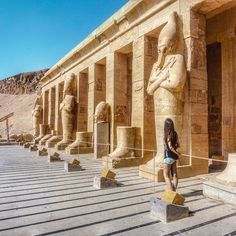Deir el-Bahari is the temple of Hatshepsut, a beautiful queen, the most beautiful woman who ruled in the days of the Pharaohs, and the slave is a funerary temple built from limestone and consists of three floors and huge columns
The Temple of Hatshepsut is distinguished at the same time that we find on its walls inscriptions of marine expeditions sent by Queen Hatshepsut to the country of Punt for trade and to bring incense and myrrh from those countries. The pharaohs used to present incense to their gods to their satisfaction, and many Egyptian pharaohs recorded this in paintings on their temples showing them making offerings and incense to various deities. In addition to incense and myrrh, the missions of Hatshepsut also transported rare trees, trees and animals not found on the land of Egypt, and tiger furs that were worn by a certain class of the priesthood of Egypt.
The design of the Temple of Hatshepsut is completely different from the design of the ancient Egyptian temples, which consisted of a large edifice (a huge portal) followed by a colonnade hall, then a smaller edifice, then a colonnade hall, then a third edifice, then a pillared hall that ends with the sanctuary of the god. Here the edifice has been replaced by a portico and the colonnade has been replaced by balconies above each other and connected by sloping platforms.




